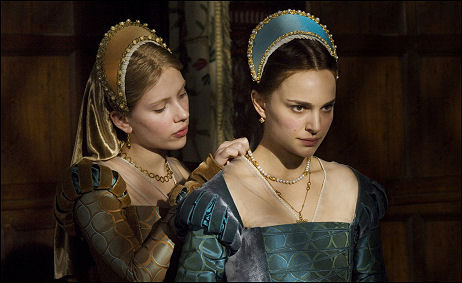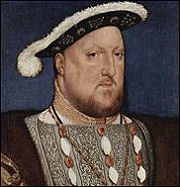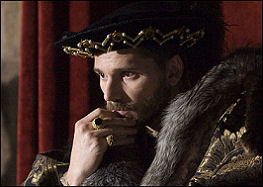Audiences don’t go to period costume dramas about famous people for absolute historical accuracy, but most of us, I think, want something that feels genuinely “of the period.” As with any film, we don’t want to feel as if actors are pretending to be characters or that the illusion we’re watching wouldn’t have happened without gaffers and lights and costumes and cameras and microphones. We want (most of us, anyway) to believe in a real-deal immersion — an organic sense that we’re literally visiting the past by way of Hollywood panache and a souped-up time-machine.

The Other Boleyn Girl, which opens today, is partly interested in achieving this effect. It does a decent job with costumes, sets and whatnot, and for the most part the performances are quite good. Its main order of business, though, is fulfilling the requirements of a period chick flick aimed at twenty- and thirty-something women who, its producers fear, might get bored or alienated if the real, more complex story (i.e., the one on Wikipedia or in the history books) was used. So it’s been boiled down into a tale of sisterly rivalry, loyalty and mutual suffering under the sexual dominance of ruthless men.
It’s not bad, I didn’t hate it, I wasn’t writhing in my seat. But I didn’t believe for a second that I was a fly on the castle wall in sixteenth-Century London. I felt as if I was watching a virtual reality revisiting by way of the editorial boards of In Touch, the Globe, Us and the National Enquirer.
Directed by Justin Chadwick from a script by Peter Morgan, it’s about the intertwined fates of the emotionally driven, vaguely slutty Mary Boleyn (Scarlett Johansson) and her younger, more ambitious sister Anne Boleyn (Natalie Portman) as they sought power and satisfactions through their associations (sexual and whatnot) with King Henry VIII (Eric Bana). But it might as well be about the Hilton or Spears sisters.


Henry VIII; Eric Bana in Henry/Boleyn Girl guise
Almost every step of the way The Other Boleyn Girl sends a message of comfort to its core audience. “Don’t worry about trying to get into the world of 16th Century London,” it’s saying. “We know you’d rather not leave your own lives and attitudes and accessories, even for 115 minutes. So we’re doing everything we can to tailor this story to you and your way of processing things in the year of our lord 2008.”
And so it flirts with the historical accounts of the lives of Mary, Anne and Henry, using what it likes and discarding the rest.
I don’t believe that any 16th-century woman would have had Johanssons’s bee-stung lips. (Generally speaking, British women have had lips like slices of baloney for centuries.) Even if Mary Boleyn had them, I don’t believe she would have kept her mouth suggestively parted all the time (as Johansson does here, as she’s done in every single role she’s had.) She’s either incapable of keeping her mouth closed, or she simply refuses to do it, or her directors haven’t faced the issue. This bothered me when she made The Girl with the Pearl Earring and it’s been driving me more and more insane in the years since.
If the producers had any interest in casting an actor who looked like the actual King Henry VIII, they would have hired Donal Logue. They went with Bana for obvious reasons. By this same logic Steven Spielberg should hire Ryan Reynolds to play Abraham Lincoln. Why not?

The story seems a little rushed at times. People run into each other in the halls, say a few words, make a decision and move on. The actors have been told to do a lot of glaring and frowning. Johansson, in particular. I found this irksome. The film starts to feel oddly “off” during the last third, especially when the matter of incest is brought up in a certain third-act scene. The audience chortled when Portman asks Johansson, in a reference to Henry’s manner of lovemaking, “How was he with you?”
Portman delivers a convincing Anne, though. She has ample amounts of ambition, nerve, chutzpah. But I just rented Anne of a Thousand Days, the 1969 film about more or less the same story (minus the attention paid to Mary), and I’m afraid that Genevieve Bujold does a better job of it.
Kristin Scott Thomas does a superb job as the mother of Mary and Anne. It’s probably the finest performance in the film.









